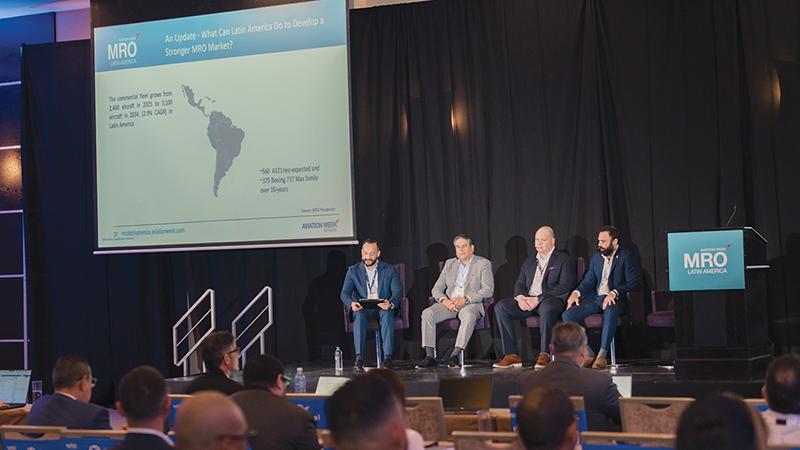This article is published in Aviation Week & Space Technology and is free to read until May 15, 2025. If you want to read more articles from this publication, please click the link to subscribe.
North America’s MRO Headaches Could Mean Opportunity For Latin America

MRO Latin America panelists discussed strengthening the region’s aftermarket (from left): Wilmer Lopez, AJW Group managing director for Latin America; Aeroman CEO Alejandro Echeverria; Carl Glover, senior vice president of sales and marketing for the Americas, AAR Corp.; and Ramiro Rojas, procurement manager for finance at Flybondi.
Tight maintenance capacity, labor shortages and geopolitical uncertainty in the U.S. could drive opportunities for Latin American MROs, but aftermarket stakeholders in the region agree companies must act soon to take advantage of the situation.
At Aviation Week Network’s recent MRO Latin America conference in Panama City, attendees were optimistic about regional market dynamics. An audience poll indicated half think the Latin American MRO market’s performance over the last few years has been promising and that now is “a good moment to invest,” while another 23% believed it is progressing well.
Alejandro Echeverria, CEO of El Salvador-based Aeroman, said parent company MRO Holdings’ businesses have had full hangars for the last few years, which has created pressure to develop more capacity. He said Aeroman plans to continue expanding not only its airframe capabilities, but also its engineering, planning and supply chain expertise to boost efficiency.
According to the Aviation Week Network’s 2025 Commercial Fleet & MRO Forecast, about 5% of global MRO demand in the next decade will be in Latin America. The region’s in-service fleet will increase by 29% over the next 10 years to about 3,100 aircraft, and about 3,000 new engine deliveries are expected. While the region’s MRO insourcing is up 1% since last year to $1.7 billion, the forecast also shows $2.4 billion of Latin American heavy airframe and engine overhaul is outsourced. Only two of the world’s top 10 engine MRO contracts are in Latin America, with most of the export market going to regions such as North America and Europe.
Rimsky Buitrago, CEO of Costa Rican MRO Coopesa, said several factors are expected to drive more work to Latin America, such as a shortage of skilled labor in the U.S., geopolitical effects on oil prices and changing dynamics in maintenance contracts. He noted that customers now prefer longer-term contracts.
“They don’t want 12-month contracts; they want 3-5 year contracts,” he said. “They don’t like the fixed cost structure of maintenance they have in airlines in the U.S., so they prefer flexible labor structures like the ones they find in Latin America.”
While North American MRO providers increasingly have recruited skilled labor from Latin America, some experts believe this trend may reverse in the current political and economic environment.

“From my perspective, the cost of living in Latin America has a big advantage to the U.S.,” said Rafael Gomez Miaja, CEO of Mexican maintenance provider MRO Iberoamerica. “When [technicians] move to the U.S., at the end of the day, the purchasing power doesn’t change a lot, so it is not a long-term solution to export technicians to the U.S., especially in the current political environment.
“What I see as an alternative is careful investment in Latin America so we can recruit the best talent within our local labor market, in which those [U.S. tariffs] allow us to be very competitive in recruiting good technicians, and that can be a lot more sustainable in the long run,” he added.
Buitrago noted airlines are looking to Latin America for more availability, capacity and lower labor costs. However, he said the region also is experiencing challenges from the skilled labor shortage and supply chain delays—and this could grow if more MROs sprout up in Latin America.
“New MROs will drive prices downward, so that puts more pressure on the incumbent MROs, because right now, even though we have the advantage of low-cost, skilled labor compared to the U.S., we have tremendous pressures in terms of salaries and retention of our people,” he said. “You have this stealing [of workforce] back and forth from other MROs. So these are all problems derived from this offshoring.”
However, speakers seemed to agree that Latin American aftermarket stakeholders should prioritize growth in the region to seize the moment.
“My recommendation is to start collaboration with Latin American operators and actors as soon as possible because I think some operators in the North are already presenting 5- and 10-year plans, so it is important to start as soon as possible,” Echeverria said. “Developing a new MRO may take 3-5 years in terms of training, capabilities, equipment, tooling, infrastructure, etc.,” he explained, emphasizing the importance of collecting as much information as possible to create a business case and develop the resources and support necessary to grow capacity.
“The resources [necessary] are huge if you want to implement additional capacities, whether it’s aircraft engines, components or whatever,” Echeverria added. “We need to train and recruit people. We need infrastructure. We need development. And that takes time.”
Carl Glover, AAR Corp.’s senior vice president of sales and marketing for the Americas, echoed these sentiments. “None of us can build hangars overnight. This is a 10-15 year road map,” he said. “How does that present?”
Glover listed several approaches Latin American countries could take to grow MRO capacity, including foreign direct investment, joint venture partnerships or alignment of regional MROs on behavior and strategy to bring support into the region.
Alton's Annual Top 10
During the MRO Latin America conference, Jonathan Berger, managing director of Alton Aviation Consultancy, shared his popular Latin American MRO Top 10 list, which tracks notable developments in the region.
10. Aeromexico was the No. 1 airline globally in on-time performance for the first time in its company history.
9. Mexicana Airlines lost $1.72 billion in 2024, costing the operator $210 per passenger per flight.
8. Uruguay launched SUA, the first Latin American airline to operate the Airbus A220, under a wet lease with AirBaltic.
7. Arajet recently announced U.S. flights.
6. APAS Chile invested in a new hangar as the first independent MRO in Santiago.
5. The FAA published its final rule mandating drug and alcohol testing in non-U.S. repair stations by 2027.
4. Intergovernmental organization BRICS approved Cuba, Bolivia and 11 other countries as “partner states.”
3. GA Telesis opened a new headquarters for Latin America and Caribbean in San Salvador, El Salvador.
2. Gol and Azul entered a preliminary agreement to merge.
1. Coopesa’s director of sales and marketing, Rodolfo Solis, won Alton Aviation’s Latin American MRO Lifetime Achievement Award.





